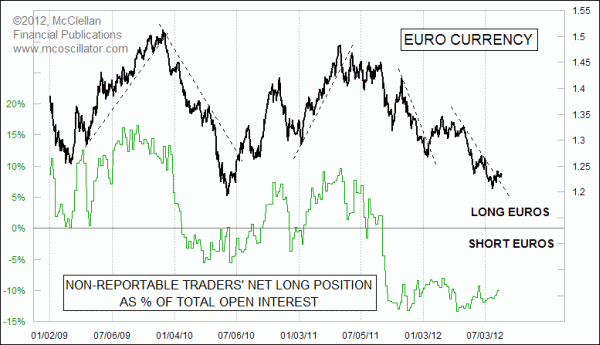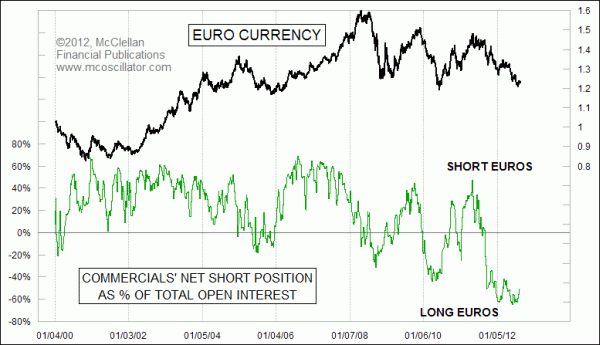This is a follow up the the commitment of traders piece I posted a couple of months ago on the “smart money/dumb money” view of the euro. At that time, the dumb money was short and the commercial traders “smart money” was getting long. The commercial traders always win. By the way, while everyone was walking around donned in Kevlar purchased from the Armageddon Party Shop, the DAX has quietly rallied about 18%. As I always say, turn off the noise, as you’re only enabling the Ron Insana’s of the world.
From McClellan:
Rumors of the collapse of the European Union have been around almost since the Maastricht Treaty was finalized in 1993. They have become more persistent lately with Greece’s debt reorganization and with other countries seemingly on the brink.
In such an environment, one might think that the euro currency would be in danger as well. But that is not the way that the “smart money” traders are betting.
This week’s chart looks at the net position of “commercial” traders of euro currency futures, as reported by the CFTC in the weekly Commitment of Traders (COT) Report. The CFTC breaks down its reporting of traders’ positions into 3 groups: commercial, non-commercial, and non-reportable. The commercial traders are the ones holding the biggest positions, and are generally assumed to be the big banks and investment firms.
Non-commercial traders are in the middle in terms of position size, and are generally assumed to be hedge funds and the like. Non-reportable traders are ones whose positions in a given futures contract are so small that the CFTC figures they are not worth bothering to have their positions reported individually.
The general assumption when examining any COT data is that the big commercial traders are the “smart money”, and that is usually the way to bet. But there are exceptions to that from time to time, as well as important nuances about how to understand what the data are telling us.
Earlier in 2012, commercial traders of euro futures moved to their biggest net long position in the history of the euro currency. That is a big bet on the euro going up in value versus the dollar. One important point to understand, though, is that while the commercial traders usually end up being proven right in the end, they often get to a big lopsided position early. So just because they had moved to a big net long position earlier in 2012 was not enough by itself to make the euro turn up.
Now the euro appears to be turning up, and finally proving the commercials correct. At the same time, the small traders counted in the “non-reportable” category are betting on the euro continuing its decline.

As a group, the non-reportable traders actually turned out to have been right in getting short in a big way late in 2011. But as a group, they tend to stay too long at the party, and then have to madly cover their positions when the market moves against them. The euro currency has now broken its declining tops line, and history shows that these breaks tend to matter for marking changes in trend direction.
The COT Report comes out on Fridays, reflecting positions held as of the preceding Tuesday. In our Daily Edition on Fridays, we cover the highlights of what the COT data are showing on selected futures contracts. You can see a sample of our Daily Edition here.

